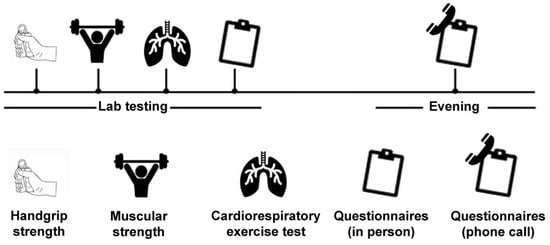-
 The Experiences of Older Adults with Dementia of “Balance Wise”—An Individual or Group-Delivered Exercise Programme: A Qualitative Study
The Experiences of Older Adults with Dementia of “Balance Wise”—An Individual or Group-Delivered Exercise Programme: A Qualitative Study -
 “Giving the People Who Use the Service a Voice”: Student Experiences of University Disability Services
“Giving the People Who Use the Service a Voice”: Student Experiences of University Disability Services -
 Social Participation and Perceived Quality of Environment of Adults with Disabilities
Social Participation and Perceived Quality of Environment of Adults with Disabilities
Journal Description
Disabilities
Disabilities
is an international, peer-reviewed, open access journal on the physical, biopsychosocial, and environmental aspects of disability, published quarterly online by MDPI.
- Open Access— free for readers, with article processing charges (APC) paid by authors or their institutions.
- High Visibility: indexed within Scopus, EBSCO, and other databases.
- Rapid Publication: manuscripts are peer-reviewed and a first decision is provided to authors approximately 27 days after submission; acceptance to publication is undertaken in 4.6 days (median values for papers published in this journal in the second half of 2023).
- Recognition of Reviewers: APC discount vouchers, optional signed peer review, and reviewer names published annually in the journal.
Latest Articles
The Leisure Time Physical Activity Questionnaire for People with Disabilities: Validity and Reliability
Disabilities 2024, 4(2), 321-331; https://doi.org/10.3390/disabilities4020021 - 23 Apr 2024
Abstract
There is an urgent need for valid and reliable measures of physical activity (PA) participation for use among people with physical and/or sensory disabilities. This study involved adapting the Leisure Time PA Questionnaire for People with Spinal Cord Injury for use in individuals
[...] Read more.
There is an urgent need for valid and reliable measures of physical activity (PA) participation for use among people with physical and/or sensory disabilities. This study involved adapting the Leisure Time PA Questionnaire for People with Spinal Cord Injury for use in individuals with disabilities (i.e., the LTPAQ-D) and performing a preliminary evaluation of its content validity, construct validity, and same-day test–retest reliability in people with disabilities. User interviews assessed the content validity (n = 5). A cross-sectional study assessed the construct validity and same-day test–retest reliability (n = 27, 45 ± 21 years). Participants completed the LTPAQ-D, other self-report measures of aerobic and strength training PA, as well as tests of cardiorespiratory fitness (i.e., peak oxygen consumption (
(This article belongs to the Special Issue Leisure and Sport Activities among People with Disabilities: Opportunities and Challenges)
►
Show Figures
Open AccessArticle
Empowering Potential of the My Assistive Technology Guide: Exploring Experiences and User Perspectives
by
Elsa M. Orellano-Colon, Angelis Fernández-Torres, Nixmarie Figueroa-Alvira, Bernice Ortiz-Vélez, Nina L. Rivera-Rivera, Gabriela A. Torres-Ferrer and Rubén Martín-Payo
Disabilities 2024, 4(2), 303-320; https://doi.org/10.3390/disabilities4020020 - 19 Apr 2024
Abstract
►▼
Show Figures
The use of assistive technology (AT) devices enhances older adults’ function in daily activities. However, the lack of awareness of AT among potential AT users has been identified as a major barrier to its adoption. This study aimed to assess the quality of
[...] Read more.
The use of assistive technology (AT) devices enhances older adults’ function in daily activities. However, the lack of awareness of AT among potential AT users has been identified as a major barrier to its adoption. This study aimed to assess the quality of the Mi Guía de Asistencia Tecnológica (MGAT) web app, which provides information on AT, from the perspective of older Latinos with physical disabilities, and to explore their experience using the MGAT. We employed a convergent parallel mixed-method design involving 12 older Latinos living in Puerto Rico. In Phase I, the researchers trained the participants in the use of the MGAT. In Phase II, participants were encouraged to use it for 30 days. In Phase III, the participants completed the User Mobile Application Rating Scale and individual interviews, analyzed with descriptive statistics and a directed thematic content analysis. The quality of the MGAT was rated high in both the objective (mean = 3.99; SD = 0.7) and subjective (mean = 4.13; SD = 1.1) domains. Qualitative data revealed the MGAT was accessible, usable, desirable, credible, useful, and valuable to increasing older Latinos’ AT knowledge, function, and autonomy. The MGAT has the potential to increase AT awareness and adoption among older adults.
Full article
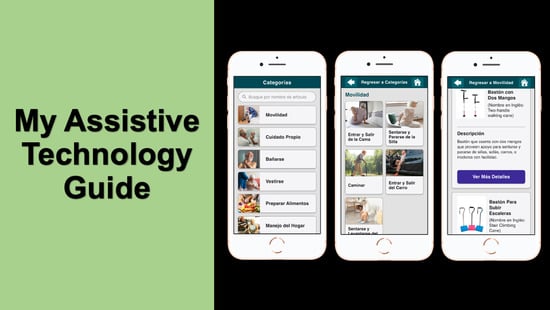
Graphical abstract
Open AccessArticle
Examining the Changes in Problem Behaviours and Communication of Persons with Intellectual and Developmental Disabilities after Transitioning from an Institutional Setting to the Community
by
Kayla Kostal, Maria Baranowski, Hygiea Casiano, Margherita Cameranesi, Lindsay McCombe and Shahin Shooshtari
Disabilities 2024, 4(2), 290-302; https://doi.org/10.3390/disabilities4020019 - 12 Apr 2024
Abstract
Worldwide, the community transition process away from institutions has increased in the past 30–50 years among persons with severe intellectual and developmental disabilities. This process, also known as “deinstitutionalization”, could potentially impact problem behaviors and communication. This study examined the impacts of community
[...] Read more.
Worldwide, the community transition process away from institutions has increased in the past 30–50 years among persons with severe intellectual and developmental disabilities. This process, also known as “deinstitutionalization”, could potentially impact problem behaviors and communication. This study examined the impacts of community transitions on behavioural and communication outcomes in Canadians with intellectual and developmental disabilities. Data were collected using the Comprehensive Health Assessment Program and medical chart reviews. Descriptive, aggregate-level, and individual-level analyses were conducted for 32 adults who transitioned to community living. Descriptive analyses and the McNemar Chi-Square Test were conducted. Following community transitions, the study group experienced a significant decrease in problem behaviours and changes in communication. The study findings suggest that deinstitutionalization could provide effective strategies for addressing problem behaviors and fostering improvements in communication, promoting the well-being and quality of life of persons with intellectual and developmental disabilities.
Full article
(This article belongs to the Special Issue Mental and Physical Health and Well-Being of Individuals with Intellectual and Developmental Disabilities)
►▼
Show Figures
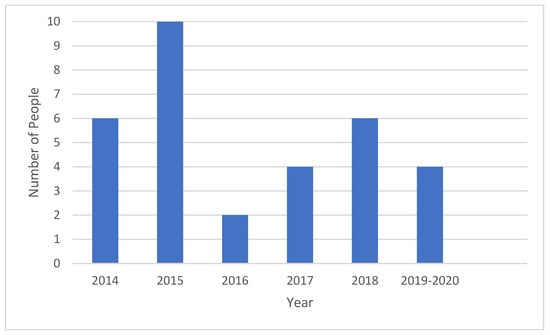
Figure 1
Open AccessArticle
Minimally Verbal Individuals with Autism Spectrum Disorders/Intellectual Disability and Challenging Behaviors: Can Strategic Psychiatric Treatment Help?
by
Jessica A. Hellings, Saras Chen Singh, Sham Singh and An-Lin Cheng
Disabilities 2024, 4(2), 277-289; https://doi.org/10.3390/disabilities4020018 - 10 Apr 2024
Abstract
(1) Background: Psychiatrists are increasingly required to treat minimally verbal (MV) individuals with autism spectrum disorder (ASD), intellectual disability (ID) and behavior problems without much published guidance. (2) Methods: We reviewed 80 charts of MV patients managed strategically for challenging behaviors,
[...] Read more.
(1) Background: Psychiatrists are increasingly required to treat minimally verbal (MV) individuals with autism spectrum disorder (ASD), intellectual disability (ID) and behavior problems without much published guidance. (2) Methods: We reviewed 80 charts of MV patients managed strategically for challenging behaviors, following IRB approval. Data extracted included demographics, ASD/ID level, diagnoses, epilepsy and medications. In this descriptive study, we examined the course of assessment and treatment and made recommendations for a strategic, person-centered approach. (3) Results: Of 53 males and 27 females, mean age 34 years (range 7–76), all had ID; 75 had ASD (94%). Diagnoses included seizures in 40/80 (50%), frequent aggression (89%), self-injury (80%), attention-deficit hyperactivity disorder (ADHD) (64%) and obsessive compulsive disorder (OCD) (34%). The commonest medication classes adjusted were antiseizure medications, antipsychotics, and non-stimulant ADHD medications. (4) Conclusions: Clinical impressions suggested that this strategic psychiatric approach was beneficial, notably a review of antiseizure and all other medications for polypharmacy, behavioral and other side effects, followed by a review of possible childhood/current ADHD and a trial of low-dose non-stimulant ADHD medications if warranted. Low-dose risperidone was often effective and tolerable for irritability and self-injury.
Full article
(This article belongs to the Special Issue Mental and Physical Health and Well-Being of Individuals with Intellectual and Developmental Disabilities)
Open AccessSystematic Review
Online Child Sexual Exploitation and Abuse of Children and Adolescents with Disabilities: A Systematic Review
by
Garazi Álvarez-Guerrero, Deborah Fry, Mengyao Lu and Konstantinos Kosmas Gaitis
Disabilities 2024, 4(2), 264-276; https://doi.org/10.3390/disabilities4020017 - 09 Apr 2024
Abstract
►▼
Show Figures
Online child sexual exploitation and abuse (OCSEA) is a rising global problem affecting children and adolescents worldwide. Despite the escalating prevalence of OCSEA, there is limited research specifically focusing on children and adolescents with disabilities. To bridge this gap, this systematic review was
[...] Read more.
Online child sexual exploitation and abuse (OCSEA) is a rising global problem affecting children and adolescents worldwide. Despite the escalating prevalence of OCSEA, there is limited research specifically focusing on children and adolescents with disabilities. To bridge this gap, this systematic review was conducted to identify the prevalence, nature and associated risk factors of OCSEA of children and adolescents with disabilities. Following the PRISMA Statement, this systematic review included scientific evidence from 12 academic databases and the gray literature published between 1993 and 2023. A total of 13 studies were extracted, and thematic analysis was conducted to analyze the data. The findings of this systematic review reveal the characteristics such as the gender, age and type of disabilities of OCSEA victims. Perpetrators use diverse techniques, including online grooming, manipulation, and cyber-threats, resulting in consequences such as mental health issues and social isolation of victims. The associated risk factors include lack of parental monitoring, social isolation, and low risk perception. The results of this research provide crucial insights into OCSEA of children and adolescents with disabilities, emphasizing the need for targeted interventions and further exploration in this understudied area.
Full article

Graphical abstract
Open AccessEditorial
The Continued Evolution of Disabilities, an Inter- and Multi-Disciplinary Journal of Disability Research
by
Reinie Cordier
Disabilities 2024, 4(1), 262-263; https://doi.org/10.3390/disabilities4010016 - 21 Mar 2024
Abstract
Disabilities continues to grow in stature and attract quality submissions from scholars across the globe [...]
Full article
Open AccessArticle
Public Transport in the Disabling City: A Narrative Ethnography of Dilemmas and Strategies of People with Mobility Disabilities
by
Juan Camilo Mansilla, Normand Boucher and François Routhier
Disabilities 2024, 4(1), 228-261; https://doi.org/10.3390/disabilities4010015 - 18 Mar 2024
Abstract
Access to transport is key to people’s movement in cities, their social participation, and personal development. People with mobility disabilities (PMDs) face additional barriers when using public transport. The objective of this study is to identify the dilemmas that PMDs face in their
[...] Read more.
Access to transport is key to people’s movement in cities, their social participation, and personal development. People with mobility disabilities (PMDs) face additional barriers when using public transport. The objective of this study is to identify the dilemmas that PMDs face in their daily mobility practices and their coping strategies, in particular the ways in which these dilemmas and strategies are influenced by both personal and environmental characteristics. We conducted ethnographic research, utilizing narrative interviews, life stories, focus groups, and participant observations. Our aim was to analyse multiple experiences of mobility in situations of disability in Quebec City, Canada. This study engages the following research question: how do PMDs navigate their social environment, considering the impact of personal, social, and physical landscape factors on their mobility strategies? Depending on the accessibility of fixed-route public buses and the availability of public paratransit services, what are the dilemmas that PMDs face and how do they shape their mobility strategies? Using the three-dimensional model of narrative analysis, we present a narrative ethnography of participants’ dilemmas and strategies about their experiences on public transport. Five dilemmas are examined. Through this methodology, we propose to extend the study of “constellations of mobility” by including the notion of strategies as an experiential outcome between personal and physical landscape factors, practices, and meanings of mobility. This offers new research perspectives both in disability and mobility studies and in the understanding of urban accessibility experiences in situations of disability.
Full article
(This article belongs to the Special Issue Mobility, Access, and Participation for Disabled People)
►▼
Show Figures
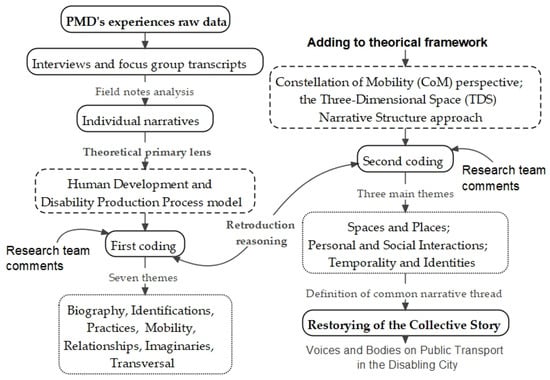
Figure 1
Open AccessArticle
Wheelchair Dance: Exploring a Novel Approach to Enhance Wheelchair Skills, Belongingness and Inclusion among Children with Mobility Limitations
by
Jade Berthiaume, Claire Cherriere, Béatrice Ouellet, Laurence Éthier, Paula W. Rushton, Martin Lemay and Krista L. Best
Disabilities 2024, 4(1), 212-227; https://doi.org/10.3390/disabilities4010014 - 18 Mar 2024
Abstract
Playful approaches are recommended to enhance wheelchair skills training with young people. Inclusive dance allows participants to discover motor skills and improve social participation. Integrating wheelchair skills training into dance has not been evaluated. This study aimed to explore participants’ experiences in dance
[...] Read more.
Playful approaches are recommended to enhance wheelchair skills training with young people. Inclusive dance allows participants to discover motor skills and improve social participation. Integrating wheelchair skills training into dance has not been evaluated. This study aimed to explore participants’ experiences in dance while integrating wheelchair skills, and the influence of dance on wheelchair skills and wheelchair use confidence in young people. A convergent mixed-methods design was used during a one-week dance camp. Data collection combined observations, two focus groups (with young dancers who used manual wheelchairs and with professional dancers without disabilities), and evaluation of wheelchair skills and confidence. Data analyses included deductive thematic analysis guided by the Quality Parasport Participation Framework, merged with pre–post comparisons in wheelchair skills and confidence. Three young female dancers were 11, 12 and 15 years of age and three professional female dancers were 22, 27 and 27 years of age. Emergent themes included skill mastery, belongingness, and supportive environments. There were improvements in wheelchair skills and confidence (16.7%, 19.4%, 16.7%; 0.8%, 11.4%, 4.5%, respectively). Participants described overall positive experiences with the dance camp and perceived enhanced skills and confidence. This study advances knowledge about innovative approaches to integrate wheelchair skills training for young people. Future larger-scale controlled studies are needed to determine efficacy.
Full article
(This article belongs to the Special Issue Mobility, Access, and Participation for Disabled People)
►▼
Show Figures
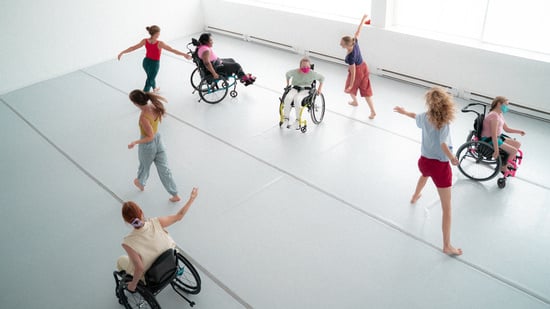
Graphical abstract
Open AccessArticle
Examining Model Similarity for Exercise Self-Efficacy among Adults Recovering from a Stroke: A Community-Based Exercise Program
by
Olivia L. Pastore, François Jarry, Jammy Zou, Jennifer R. Tomasone, Luc J. Martin, Véronique Pagé and Shane N. Sweet
Disabilities 2024, 4(1), 198-211; https://doi.org/10.3390/disabilities4010013 - 15 Mar 2024
Abstract
►▼
Show Figures
We used a single-case experimental research design to examine the effect of modelling (peer versus non-peer) on exercise self-efficacy in stroke survivors who participated in a community-based exercise program. Data were obtained using an ABCA design: (A1) no model/baseline 1 (3
[...] Read more.
We used a single-case experimental research design to examine the effect of modelling (peer versus non-peer) on exercise self-efficacy in stroke survivors who participated in a community-based exercise program. Data were obtained using an ABCA design: (A1) no model/baseline 1 (3 weeks); (B) peer model (6 weeks); (C) non-peer model (6 weeks); and (A2) no model/baseline 2 (3 weeks). Four participants completed self-efficacy questionnaires after each weekly session. Overall, participants reported higher exercise self-efficacy in the model conditions (Cohen’s d range from −0.37 to 4.22), with ratings appearing highest for the non-peer model. Modelling in general may help stroke survivors increase their exercise self-efficacy. Lastly, we provide our reflections on the pragmatics of completing a study within a community setting.
Full article
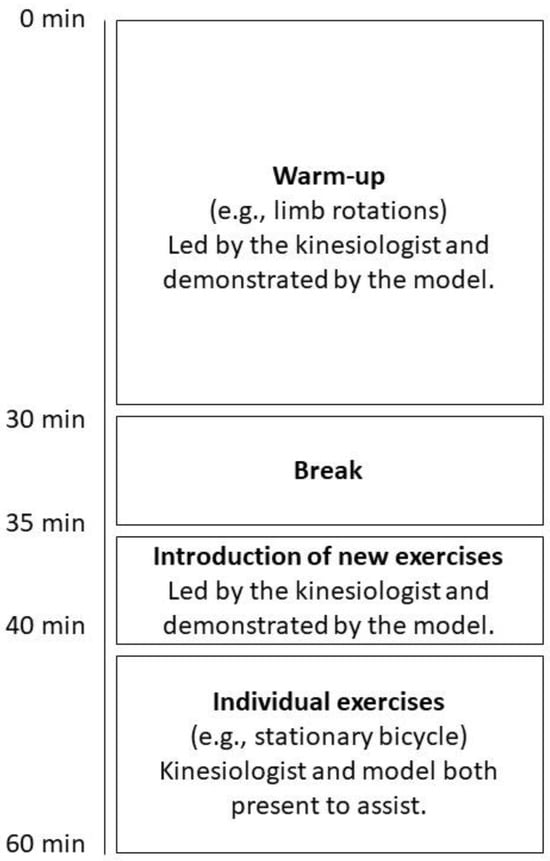
Figure 1
Open AccessArticle
Feasibility of a Peer-Led Leisure Time Physical Activity Program for Manual Wheelchair Users Delivered Using a Smartphone
by
Krista L. Best, Shane N. Sweet, Jaimie F. Borisoff, Kelly P. Arbour-Nicitopoulos and François Routhier
Disabilities 2024, 4(1), 183-197; https://doi.org/10.3390/disabilities4010012 - 07 Mar 2024
Abstract
Active living lifestyles for wheelchair users (ALLWheel) was developed to improve leisure time physical activity (LTPA). The purpose of this study was to assess the feasibility of the ALLWheel program. In a pilot pre-post design, 12 manual wheelchair users in three Canadian cities
[...] Read more.
Active living lifestyles for wheelchair users (ALLWheel) was developed to improve leisure time physical activity (LTPA). The purpose of this study was to assess the feasibility of the ALLWheel program. In a pilot pre-post design, 12 manual wheelchair users in three Canadian cities completed the ALLWheel program (containing 14 sessions over 10 weeks delivered by a peer using a smartphone). Feasibility indicators were collected for process, resources, management, and intervention—before, during, and after ALLWheel. Exploratory outcomes were collected for LTPA (primary outcome), motivation, self-efficacy, and satisfaction with autonomy support and goal attainment—at baseline, immediately following ALLWheel, and three months later. Feasibility was evaluated using a priori criteria for success (yes/no), and within-subjects comparisons were made to explore the change in exploratory outcomes. The participants were 48.9 ± 15.1 years of age and women (66.7%), and had spinal cord injury (41.7%) or multiple sclerosis (16.7%). Feasibility was achieved in 11 of 14 indicators, with suggestions to consider subjective reports of LTPA as the primary outcome in a future randomized controlled trial to overcome limitations with device-based measures and to use strategies to enhance recruitment. Mild-intensity LTPA and satisfaction with goal attainment improved after the completion of ALLWheel. With minor modifications, it is feasible that ALLWheel can be administered to wheelchair users by a peer using a smartphone.
Full article
(This article belongs to the Collection Exclusive Papers Collection of Editorial Board Members of Disabilities)
Open AccessArticle
Accessibility, Functioning, and Activities of Daily Living with Visual Impairment amongst Adults from Minority Ethnic Communities in the UK
by
Theofilos Kempapidis, Nikki Heinze, Asharee K. Green and Renata S. M. Gomes
Disabilities 2024, 4(1), 163-182; https://doi.org/10.3390/disabilities4010011 - 29 Feb 2024
Abstract
Visual impairment (V.I.) has been associated with a negative impact on activities of daily living (ADL) and navigation outside the home. Adults from minority ethnic communities are projected to make up an increasing proportion of the V.I. population in the UK, yet the
[...] Read more.
Visual impairment (V.I.) has been associated with a negative impact on activities of daily living (ADL) and navigation outside the home. Adults from minority ethnic communities are projected to make up an increasing proportion of the V.I. population in the UK, yet the evidence relating to their experiences of living with V.I. is limited. This article uses data collected by the V.I. Lives Survey, between December 2019 and November 2020. Using secondary analysis of anonymised survey data, this article explores self-reported functioning relating to ADL, navigation outside of the home, and use of technology to access information in a matched control sample of adults from minority ethnic (MEC) and white communities (WC). The findings showed that most issues relating to self-efficacy, accessibility of public environments, and technology were significantly more important to MEC than WC participants. A significantly higher proportion of MEC participants required frequent help with cooking, received support for ADL from siblings and other family members, and had their shopping delivered. WC participants were significantly more likely to receive help with shopping from their spouse/partner and use public transport as much as they liked. Future research will need to confirm these findings in a larger sample and explore the reasons for them.
Full article
Open AccessArticle
Examining Parental Stress and Autism in the Early Days of the Pandemic: A Mixed-Methods Study
by
Ban S. Haidar and Hedda Meadan
Disabilities 2024, 4(1), 144-162; https://doi.org/10.3390/disabilities4010010 - 23 Feb 2024
Abstract
►▼
Show Figures
In this convergent parallel mixed-methods study, we investigated the early impact of the COVID-19 stay-at-home mandate in Illinois on 16 caregivers of children with autism. Our goal was to understand contributors to caregivers’ stress by integrating qualitative and quantitative data. Through a joint
[...] Read more.
In this convergent parallel mixed-methods study, we investigated the early impact of the COVID-19 stay-at-home mandate in Illinois on 16 caregivers of children with autism. Our goal was to understand contributors to caregivers’ stress by integrating qualitative and quantitative data. Through a joint display, we explored the intricate relationship between caregivers’ perceptions of their child’s needs, the loss of essential services, and stress levels. The caregivers’ reported needs, wishes, barriers, and coping strategies informed and corroborated final quantitative results on stress levels. Significant associations were found between stress levels and caregivers’ agreement with statements on child supervision, service loss, and perceived level of their child’s independence. These findings underscore the importance for robust support systems that enhance family resilience and validate prior research during exceptional circumstances. They offer insights for policymakers and service providers seeking to improve the well-being of families raising children with autism, particularly in times of crisis.
Full article

Figure 1
Open AccessArticle
Empowering Physically Disabled People in Vietnam: A Successful Microenterprise Model
by
June Alexander, Claire Hutchinson and Greg Carey
Disabilities 2024, 4(1), 127-143; https://doi.org/10.3390/disabilities4010009 - 16 Feb 2024
Abstract
Background: Disabled people in Vietnam are some of the most vulnerable to disadvantage. Employment involving microenterprises can provide economic empowerment and wealth generation. This qualitative study aims to address a gap in the literature regarding the establishment of microenterprises for physically disabled people
[...] Read more.
Background: Disabled people in Vietnam are some of the most vulnerable to disadvantage. Employment involving microenterprises can provide economic empowerment and wealth generation. This qualitative study aims to address a gap in the literature regarding the establishment of microenterprises for physically disabled people in Vietnam. Method: Semi-structured interviews were undertaken with seven physically disabled individuals, including the founder and Director of ‘Company of Grace’ a non-governmental organisation with a mission to support physically disabled people in establishing their own microenterprises. Company of Grace (COG) supported six entrepreneurs in establishing microenterprises that provided English language instruction to school-aged children after regular school hours. Data were analysed utilising a framework that improves the probability of entrepreneurial success in developing countries. This framework aided in examining the approach of establishing microenterprises by the non-government organisation. Results: The physically disabled entrepreneurs reported earnings above average wages and feeling empowered by participating in the microenterprises. These feelings of empowerment were reportedly associated with greater independence, increased self-efficacy and confidence in planning for their futures. Conclusion: Microenterprises, exemplified by COG’s model, empowered disabled individuals to teach English, enhanced student engagement and fostered confidence and economic self-sufficiency among disabled entrepreneurs, thereby making a notable contribution to entrepreneurship for disability inclusion.
Full article
Open AccessArticle
The Role of Shared Resilience in Building Employment Pathways with People with a Disability
by
Perri Campbell, Erin Wilson, Luke John Howie, Andrew Joyce, Jenny Crosbie and Robyn Eversole
Disabilities 2024, 4(1), 111-126; https://doi.org/10.3390/disabilities4010008 - 30 Jan 2024
Abstract
►▼
Show Figures
For workers living with a disability, pathways to sustainable employment in the open labour market are inhibited by barriers operating at different structural and societal levels. The culture of Australia’s government employment services has applied a ‘work-first’ approach that emphasises finding people employment
[...] Read more.
For workers living with a disability, pathways to sustainable employment in the open labour market are inhibited by barriers operating at different structural and societal levels. The culture of Australia’s government employment services has applied a ‘work-first’ approach that emphasises finding people employment rather than supporting the acquisition of skills and education. The net effect of this approach is the preferencing of short-term employment solutions, with a focus on individual behaviour or so-called resilience and an emphasis on personal responsibility instead of addressing structural issues. In this paper, we explore how people with disability can be supported in finding employment through a shared resilience approach offered by a Work Integration Social Enterprise (WISE). We suggest that WISEs can provide the conditions for shared resilience by developing and sustaining networks needed to generate hybrid pathways to work and by role modelling inclusive work conditions in the open labour market.
Full article
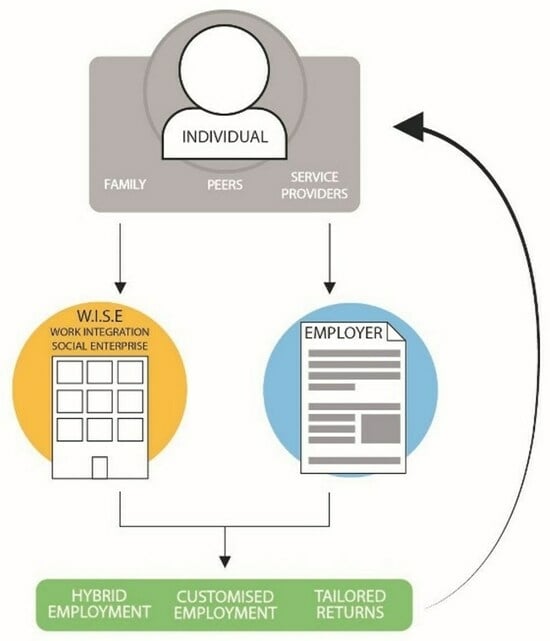
Graphical abstract
Open AccessArticle
Health Checks for People with Down Syndrome: A Pooled Analysis of Three Randomized Controlled Trials
by
Robert S. Ware, Catherine Franklin, Lyn McPherson and Nicholas G. Lennox
Disabilities 2024, 4(1), 101-110; https://doi.org/10.3390/disabilities4010007 - 26 Jan 2024
Abstract
Health checks have beneficial effects on health outcomes in adults with intellectual disability; however, little is known about their effect on people with Down syndrome. The aim of this study was to assess the effect of receiving a health check on the unmet
[...] Read more.
Health checks have beneficial effects on health outcomes in adults with intellectual disability; however, little is known about their effect on people with Down syndrome. The aim of this study was to assess the effect of receiving a health check on the unmet health needs of people with Down syndrome. A pooled analysis of three randomized trials conducted by the same Australian research team was undertaken. The trials used the same tools but differed by participant source (adults in 24 h supported accommodation, adults in private dwellings, adolescents living with parents). The intervention was a one-off health check, and the comparator was usual care. Among 216 participants, health actions were more likely to occur for those allocated to receive health checks, including increased hearing (odds ratio = 4.4; 95% confidence interval: 1.2, 16.4), vision (2.7; 1.1, 6.7), and thyroid (2.3; 1.3, 4.2) testing, and weight recording (4.7; 2.5, 8.8). Health checks conducted at the primary-care level produced substantially increased attention to the health needs of people with Down syndrome.
Full article
(This article belongs to the Special Issue Mental and Physical Health and Well-Being of Individuals with Intellectual and Developmental Disabilities)
►▼
Show Figures

Figure 1
Open AccessArticle
Health and Comorbidities in Minority Ethnic Adults Living with Visual Impairment in the UK
by
Syeda F. Hussain, Nikki Heinze and Renata S. M. Gomes
Disabilities 2024, 4(1), 79-100; https://doi.org/10.3390/disabilities4010006 - 24 Jan 2024
Cited by 2
Abstract
►▼
Show Figures
Visual impairment has been associated with mental and physical comorbidities in older adults. Research into comorbidities within minority ethnic communities (MEC) with visual impairment is yet to be explored, despite the increase in numbers. A secondary analysis of survey data collected by UK-based
[...] Read more.
Visual impairment has been associated with mental and physical comorbidities in older adults. Research into comorbidities within minority ethnic communities (MEC) with visual impairment is yet to be explored, despite the increase in numbers. A secondary analysis of survey data collected by UK-based sight loss charities provides the first insight into comorbid conditions in a matched control sample of 77 MEC and 77 White adults aged 18–85 years. Participants were matched based on age, gender, UK region, and urban/rural setting. Group differences were explored, and subgroup analysis was also carried out for the two largest subgroups within the MEC group: Asian (n = 46) and Black (n = 22). Response frequencies (n) and proportions (%) were calculated for all variables including eye conditions, vision difficulties, comorbid conditions, and exercise. The sample was predominantly young, and few significant differences were found. Sub-group analysis showed that Asian participants were more likely to report not doing any exercise, having bad health, and comorbidities including high blood pressure, dexterity, hearing and communication difficulties, and a recent emotional/psychological/mental health condition. Black participants, however, were more likely to report comorbidity, in particular physical conditions and mobility difficulties.
Full article
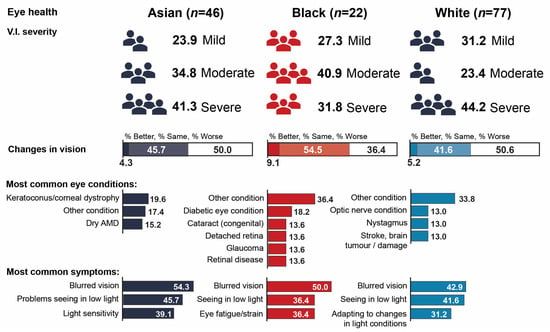
Figure 1
Open AccessArticle
Fully Digital Audio Haptic Maps for Individuals with Blindness
by
Howard Kaplan and Anna Pyayt
Disabilities 2024, 4(1), 64-78; https://doi.org/10.3390/disabilities4010005 - 09 Jan 2024
Abstract
►▼
Show Figures
Tactile maps designed for individuals with blindness can greatly improve their mobility, safety and access to new locations. While 3D-printed maps have already been demonstrated to be a powerful tool for delivering spatial information, they might not always be available. Alternatively, a combination
[...] Read more.
Tactile maps designed for individuals with blindness can greatly improve their mobility, safety and access to new locations. While 3D-printed maps have already been demonstrated to be a powerful tool for delivering spatial information, they might not always be available. Alternatively, a combination of audio and haptic information can be used to efficiently encode 2D maps. In this paper, we discuss the development and user-testing of a novel audio-haptic map creator application. Maps created using this application can provide people with blindness with a tool for understanding the navigational routes and layouts of spaces before physically visiting the site. Thirteen people with blindness tested various components of the virtual map application, such as audio, haptic feedback and navigation controls. Participants’ data and feedback were collected and analyzed to determine the effectiveness of the virtual maps as it relates to this user group’s readability and usability. The study showed that it was easy to use and that it efficiently delivered information about travel routes and landmarks that the participants could successfully understand.
Full article
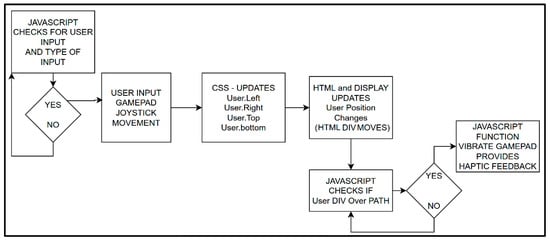
Figure 1
Open AccessReview
Queer and Disabled: Exploring the Experiences of People Who Identify as LGBT and Live with Disabilities
by
Theofilos Kempapidis, Nikki Heinze, Asharee K. Green and Renata S. M. Gomes
Disabilities 2024, 4(1), 41-63; https://doi.org/10.3390/disabilities4010004 - 30 Dec 2023
Abstract
As a minority within a minority, individuals who have a disability and identify as LGBT are at the intersection of multiple stigmatised identities. This brings with it unique challenges, including the possibility of oppression and rejection by both the LGBT and disability communities,
[...] Read more.
As a minority within a minority, individuals who have a disability and identify as LGBT are at the intersection of multiple stigmatised identities. This brings with it unique challenges, including the possibility of oppression and rejection by both the LGBT and disability communities, which can impact on identity and wider life experiences. While previous reviews have explored issues relating to intersectionality, multiple oppression, identity, acceptance, and sexuality, an overview of the impact on wider life experiences is missing. This narrative review presents empirical findings published since 2000 about the wider everyday experiences relating to attitudes and discrimination, education, employment, finances, health and well-being, support, and intimate relationships among people who identify as LGBT and have a disability.
Full article
Open AccessArticle
Perceived Barriers and Facilitators to Implementation of Inclusive Policy, Systems, and Environmental Changes
by
Cassandra Herman, Kerri Vanderbom, Karma Edwards and Yochai Eisenberg
Disabilities 2024, 4(1), 27-40; https://doi.org/10.3390/disabilities4010003 - 28 Dec 2023
Abstract
People with disabilities (PWDs) are often excluded from health-promoting activities in their communities. Inclusive policy, systems, and environmental (PSE) changes can promote access to healthy lifestyle choices for PWDs. However, implementation of inclusive PSEs in community-based settings is challenging and we lack an
[...] Read more.
People with disabilities (PWDs) are often excluded from health-promoting activities in their communities. Inclusive policy, systems, and environmental (PSE) changes can promote access to healthy lifestyle choices for PWDs. However, implementation of inclusive PSEs in community-based settings is challenging and we lack an understanding of what factors impact implementation of inclusive PSEs. The purpose of this study was to examine barriers and facilitators experienced by community coaches while planning and implementing inclusive PSEs. Semi-structured interviews (n = 10) were conducted with coaches as part of the Reaching People with Disabilities through Healthy Communities project. Interviews were coded using directed content analysis guided by the Theoretical Domains Framework and were categorized into barriers and facilitators within the COM-B framework (which identifies Capability, Opportunity, and Motivations as components that can impact Behavior). The opportunities domain, consisting of social influences and environmental context and resources, most impacted disability-inclusive PSE implementation. Within this domain, facilitators included community support, strong partnerships, technical assistance from experts, and alignment with ongoing initiatives. Barriers included the community’s lack of knowledge about disability, fear regarding resources needed for inclusive changes, and lack of resources (time, staff, funding). Supports addressing the opportunities domain should be considered to facilitate the implementation of disability-inclusive PSEs to build healthy, accessible communities for all.
Full article
Open AccessArticle
The Experiences of Older Adults with Dementia of “Balance Wise”—An Individual or Group-Delivered Exercise Programme: A Qualitative Study
by
Normala Mesbah, Meredith Perry, Keith D. Hill, Donald Manlapaz and Leigh Hale
Disabilities 2024, 4(1), 11-26; https://doi.org/10.3390/disabilities4010002 - 27 Dec 2023
Abstract
►▼
Show Figures
This study aimed to understand the experience of older adults with dementia towards, and the practicality of, the Balance Wise exercise programme. A qualitative study guided by the General Inductive Approach was employed. Ten people with dementia aged 71–87 years who completed the
[...] Read more.
This study aimed to understand the experience of older adults with dementia towards, and the practicality of, the Balance Wise exercise programme. A qualitative study guided by the General Inductive Approach was employed. Ten people with dementia aged 71–87 years who completed the exercise programme and four care partners aged 69–76 years old (three of whom also participated in Balance Wise) were interviewed in dyads. The programme (individually or group delivered) was held once a week for 30 min for 10 weeks and included balance and strength exercises, cognitive training, and other enjoyable physical activities. Interviews were thematically analysed. Three overarching themes were identified (i) decision making, (ii) comprehension, and (iii) perceived benefits. Participants acknowledged their decision to participate was influenced by ‘awareness’ about their declining memory and their ‘health belief’ about the potential benefits of exercise. ‘Perceived benefits’ were influenced by the ‘support system’ and improvement in postural stability. ‘Comprehension’ was, however, an important cognitive ability to understand the purpose of the activities in the programme and facilitated motivation. This study highlighted an important message that such programmes should be developed from the end-user perspective, and this included that the programme be flexible and safely delivered, as well as be fun and pleasurable, thus promoting socialisation.
Full article
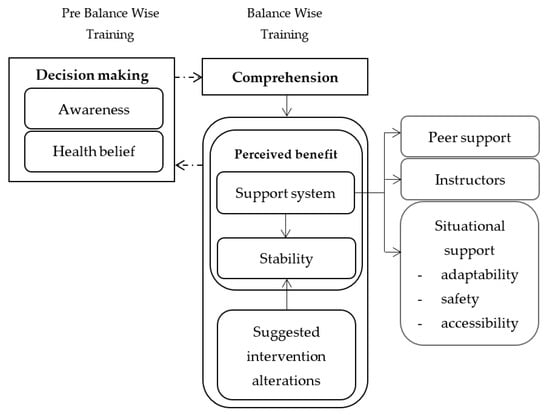
Figure 1
Highly Accessed Articles
Latest Books
E-Mail Alert
News
Topics

Conferences
Special Issues
Special Issue in
Disabilities
Mental and Physical Health and Well-Being of Individuals with Intellectual and Developmental Disabilities
Guest Editor: Janet FinlaysonDeadline: 30 June 2024
Special Issue in
Disabilities
The Care Economy and Disability Inclusion
Guest Editors: Daniel Mont, Monica Pinilla-RoncancioDeadline: 31 July 2024
Special Issue in
Disabilities
Leisure and Sport Activities among People with Disabilities: Opportunities and Challenges
Guest Editors: Kris Southby, Matthias Grunke, Janine BrachtDeadline: 31 August 2024
Special Issue in
Disabilities
Advances in Disability-Inclusive Disaster Risk Reduction
Guest Editors: Michelle Villeneuve, Tonia CrawfordDeadline: 31 December 2024
Topical Collections
Topical Collection in
Disabilities
Exclusive Papers Collection of Editorial Board Members of Disabilities
Collection Editor: Reinie Cordier

